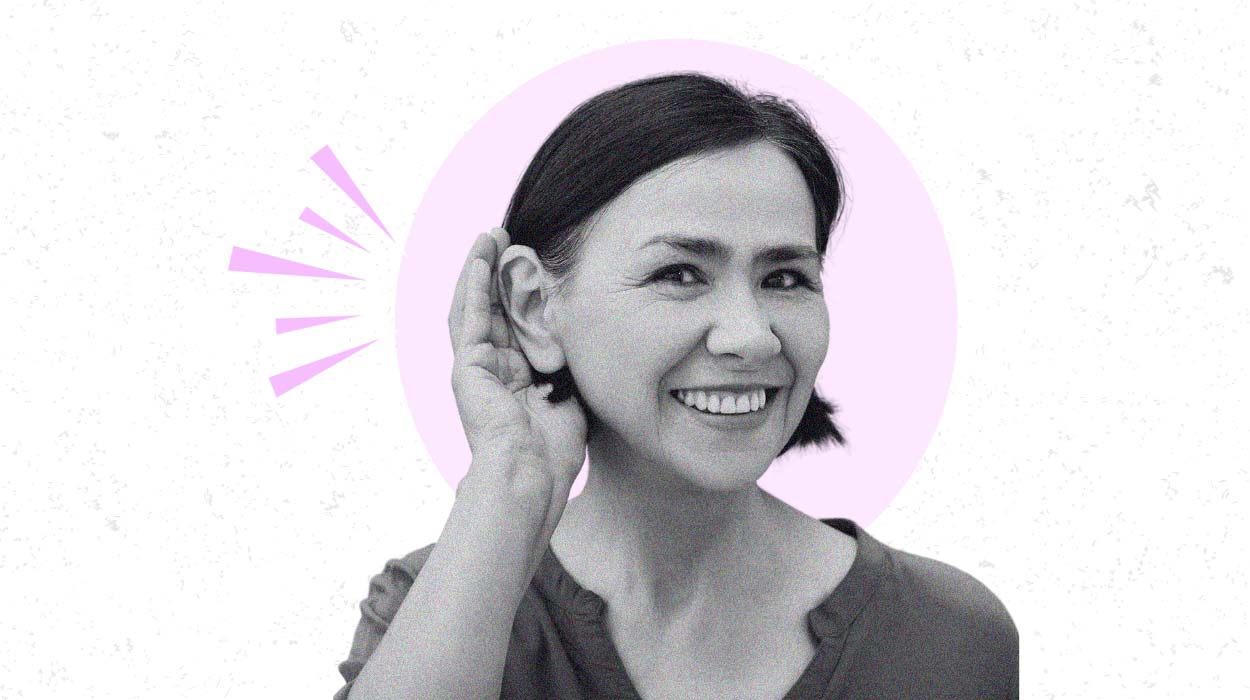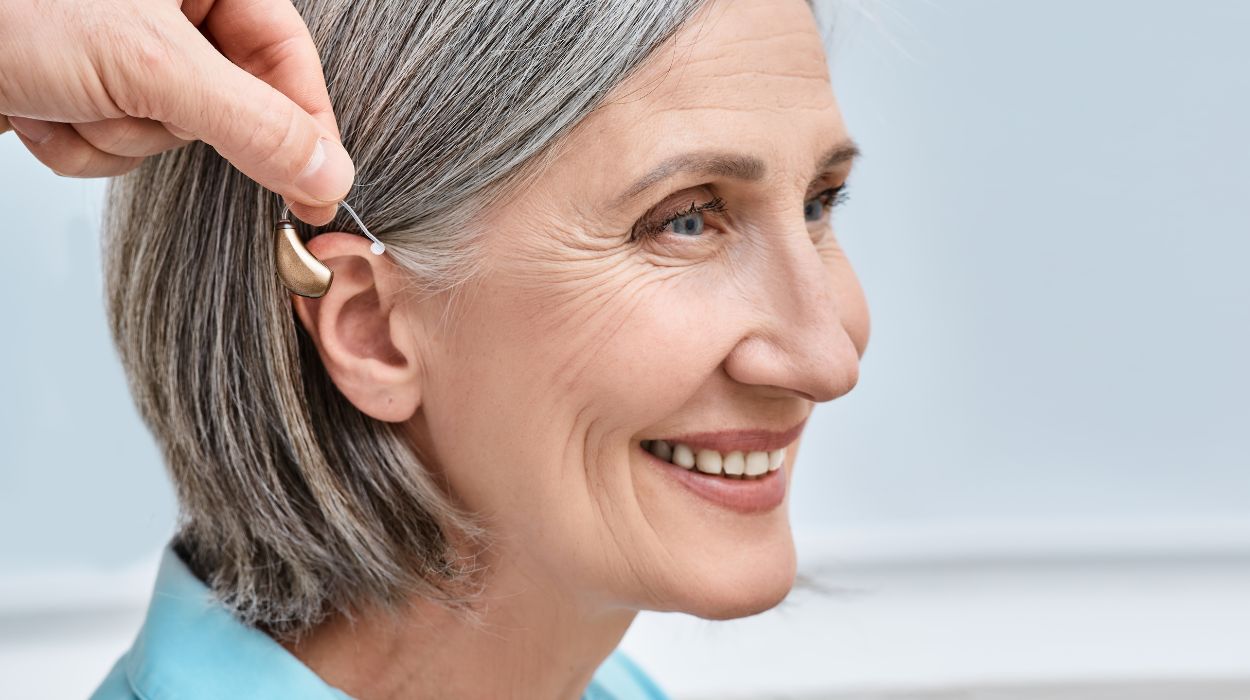 Expert's opinion
Expert's opinion
Expert's opinion
The article is a subjective view on this topic written by writers specializing in medical writing.
It may reflect on a personal journey surrounding struggles with an illness or medical condition, involve product comparisons, diet considerations, or other health-related opinions.
Although the view is entirely that of the writer, it is based on academic experiences and scientific research they have conducted; it is fact-checked by a team of degreed medical experts, and validated by sources attached to the article.
The numbers in parenthesis (1,2,3) will take you to clickable links to related scientific papers.
Conductive Hearing Loss: Symptoms, Causes & Treatments 2024

If you’ve noticed people’s voices sound more muffled and you’re constantly asking them to repeat themselves, you might have a form of hearing loss. Currently, almost 15% of Americans have some degree of hearing loss, with half of all adults in their 70s experiencing it to some degree.
Of course, age-related hearing loss isn’t the only way to get it. Children who somehow manage to get something stuck in their ear, those who get frequent ear infections, and those with impactions of ear wax can also experience conductive hearing loss.
Read on to find out how this type of hearing loss can happen, its symptoms, and how to get treatment.
Key Takeaways
- More than 30 million U.S. adults have some degree of hearing loss.
- Conductive hearing loss is when the sound doesn’t pass through the outer and middle ear to reach the inner ear.
- Symptoms may include muffled hearing, pain in the ear, and flu-like congestion in the ear.
- Hearing loss may be caused by ear infections, tumors, ear wax, or objects stuck in the ear.
- Treatments include surgery, medication, and hearing aids.
What Is Conductive Hearing Loss?
Conductive hearing loss happens when sound waves aren’t conducted through the outer and middle ear to reach the inner ear. If you have this type of hearing loss, it might be difficult to hear soft sounds, with louder ones sounding muffled.
How Does Hearing Work?
The ear comprises three parts,[1] each with an important task in making sure we perceive sound. These include
- Outer ear — the part we see, which has the external ear canal and ear drum separating the outer and middle ear.
- Middle ear — the eardrum and three small bones that transmit vibratory movements of the eardrum to the inner ear.
- Inner ear — the cochlea, the snail-shaped organ for hearing, semicircular canals that help with balance, and nerves that go to the brain collectively as the eighth cranial nerve. Hearing loss due to inner ear involvement is called sensorineural hearing loss.
The outer ear collects sound waves and channels them into the ear canal. The eardrum in the middle ear vibrates in response to these sound waves, causing the tiny bones to vibrate.
The vibrations are transmitted to the cochlea in the inner ear, which converts them into electrical signals that the brain interprets as sound. Naturally, any issue with one of these parts can lead to difficulties hearing.
Is Conductive Hearing Loss Bilateral?
Conductive hearing loss can be either unilateral, affecting only one ear, or bilateral, affecting both ears. It all depends on the underlying cause, much like how an infection or wax buildup can affect either one or both ears.
If there is damage to the small bones in both ears, such as may happen with the condition called otosclerosis, it is often bilateral.
Conductive Hearing Loss Symptoms

What does conductive hearing loss feel like? People with hearing loss often don’t notice or ignore their symptoms. Shockingly, only about one-third of people who claim they have hearing loss get their hearing tested. Without treatment, however, hearing loss can worsen.[2]
These are some of the most common symptoms associated with conductive hearing loss:
- Dizziness.
- Muffled hearing.
- Draining of the ear.
- Pain or tenderness in the ear.
- Flu-like stuffed-up ear sensations.
- Sudden or steady loss of hearing.
Some subtler signs can let you know it’s time to get a check-up, such as:
- Thinking that other people are mumbling.
- Frequently asking people to repeat themselves.
- Having trouble understanding people over the phone.
- Turning up the TV volume loudly enough for others to complain.
- Finding it difficult to follow conversations with two or more people.
- Having a hard time understanding anyone if there’s background noise.
If you’ve noticed any of these signs, it’s time to schedule a check-up and let your doctor know. It’s not always easy to admit, but getting treatment can greatly impact your overall quality of life. Daily tasks become easier to manage, and friends and family will be grateful for smoother conversations with you, too.
What Are Causes?
Conductive hearing loss is caused by various issues, such as
- Ear infections.
- Benign tumors.
- A hole in the eardrum.
- Object stuck in the outer ear.
- Outer or middle ear deformity.
- Earwax stuck in the ear canal.
- Fluid in your middle ear from allergies or colds.
- Poor Eustachian tube function, keeping fluid pressure in the middle ear.
Conductive hearing loss may also happen in children, but it’s usually related to frequent ear infections or physical obstruction. Since children often find themselves inserting things into their ears, they’re at a higher risk of developing this type of hearing loss. Cotton swabs, often used to clear wax, can compress it deep into the ear, causing a cerumen impaction.
Conductive Hearing Loss Treatments

Luckily, conductive hearing loss has treatment options that can significantly improve your quality of life, such as:
- Surgery — corrects hearing loss due to congenital ear canal absences, failure of the ear canal to open at birth, congenital absence of bones, malformations, dysfunction of the middle ear due to injury, tumors, and otosclerosis, or treatment failure for otitis media.
- Hearing Aids — conventional or bone-conduction hearing aids or a surgically implanted osseointegrated device can provide amplification as a solution.
- Medication — antibiotic or antifungal medications can treat chronic ear infections or chronic middle fluid.
Of course, before deciding on any treatment plan, you’ll need to thoroughly examine the cause, type, and degree of the hearing loss.
Diagnosis
Different hearing tests diagnose hearing loss to determine the best treatment option. They may first check your ear canal for
- Ear wax buildups and blockages.
- Ear infection and swelling.
- Congenital extra bone growth.
- Tumors.
After determining if there are any medical issues, they will diagnose your type and degree of hearing loss. There are three types: conductive — the subject of this article; sensorineural — problems with the inner ear and acoustic nerve; and mixed type — features and pathology of both.
To determine the severity of your hearing loss, your medical professional will likely perform different hearing tests,[3] such as:
- Audiogram — a graph that displays your hearing abilities at different frequencies and volumes.
- Weber test — a vibrating tuning fork-type object is placed on the forehead to determine if hearing loss is conductive vs. sensorineural hearing loss.
- Rinne test — a vibrating tuning fork is placed on the mastoid bone behind the ear and near the ear canal to determine if it’s conductive or sensorineural hearing loss and the degree of bone conduction.
Once these tests are complete, your doctor can better tell you which treatment option suits you best.
Is Conductive Hearing Loss Permanent?
In many cases, conductive hearing loss is temporary. It might even improve on its own if it’s due to earwax buildup, which can be easily removed. In most cases, however, some form of treatment is needed. This is especially true for infections where antibiotics are needed, but once you’ve recovered from the infection, your hearing should improve.
Due to frequent middle ear infections, i.e., otitis media, children may build up fluid and pressure that can’t be relieved without surgically inserting a draining tube, after which normal hearing resumes immediately; the tube naturally falls out later.
However, permanent hearing loss is more likely if the underlying cause is structural, such as a malformation in the middle ear or damage to the small ear bones. A hearing aid or cochlear implant can improve the degree of loss and restore your quality of life.
The Bottom Line
The conductive hearing loss definition is the inability of sound to pass through the outer and middle ear to reach the inner ear. It frequently occurs in children and older adults due to infections, wax build-up, tumors, or objects placed in the ear. Another conductive hearing loss example is middle ear fluid from allergies or colds.
If you notice any symptoms of hearing loss, like muffled hearing, inner ear pain, tinnitus,[4] i.e., ringing or hissing sounds, or a flu-like congestion feeling in the ear, it’s time for evaluation.
Many people don’t notice any hearing problems, but if you ask others to repeat themselves, turn up the TV, or can’t follow conversations with several people due to background noise, you may have hearing loss.
Fortunately, there are treatments available. These include specific conductive hearing loss, hearing aids, surgery, or medications, e.g., for chronic ear infections. Your doctor will run diagnostic tests to determine the type and degree of hearing loss for your best treatment plan.
If you’re reluctant to admit to hearing problems, seeing a medical professional can drastically add comfort and ease to your daily life. You’ll be able to have conversations more easily and feel more equipped to handle daily tasks.
Even though no one likes going to the doctor, getting a check-up and treatment will improve your quality of life and be well worth it.
+ 4 sources
Health Canal avoids using tertiary references. We have strict sourcing guidelines and rely on peer-reviewed studies, academic researches from medical associations and institutions. To ensure the accuracy of articles in Health Canal, you can read more about the editorial process here
- CDC (2021). Types of Hearing Loss. [online] Centers for Disease Control and Prevention. Available at: https://www.cdc.gov/ncbddd/hearingloss/types.html
- https://www.facebook.com/NIHAging (2023). Hearing Loss: A Common Problem for Older Adults. [online] National Institute on Aging. Available at: https://www.nia.nih.gov/health/hearing-loss-common-problem-older-adults
- Medlineplus.gov. (2019). Hearing Tests for Adults. [online] Available at: https://medlineplus.gov/lab-tests/hearing-tests-for-adults/
- American Tinnitus Association | The ATA is a non-profit that empowers tinnitus patients, health-care providers, and researchers. (2023). What is Tinnitus? | American Tinnitus Association. [online] Available at: https://www.ata.org/about-tinnitus/why-are-my-ears-ringing/



